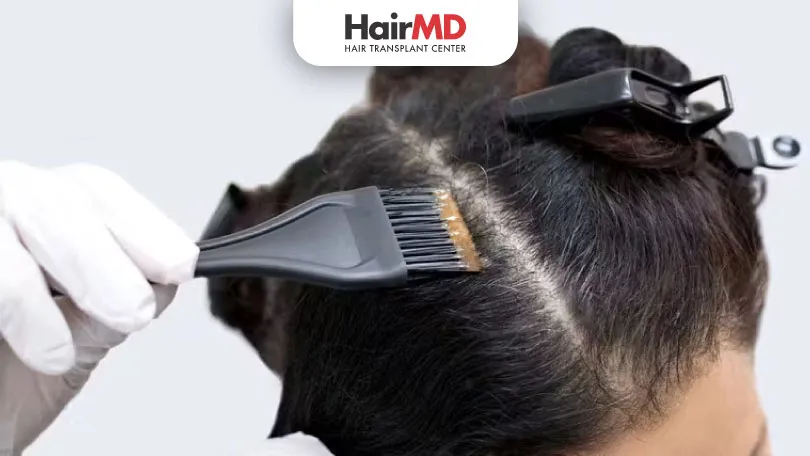17th March, 2022

Does coloring your hair lead to thinning? Learn about the effects of hair dye on hair health, potential damage, and how to minimize thinning with proper care.
Coloring or dying the hair is a common practice, mostly taken up for cosmetic reasons like covering white or grey hair, changing to a color which could look more appealing or restoring the appearance of previously damaged hair. Does coloring/dying damage the hair? Does coloring hair cause thinning? Does hair dye cause hair loss? Most individuals who opt for hair coloring have questions like these, owing to the fear of chemicals in the hair dye leading to hair damage. It is true that if the hair is exposed to harsh chemicals like the ones present in hair dyes and artificial hair coloring products, the hair may start thinning or falling out. However, is dying your hair bad for thinning hair, and if yes, then what is the safest hair dye for thinning hair? Let’s find out.
What’s covered in the article?
- Does Coloring Your Hair Lead To Thinning?
- How Much Hair Loss Is Normal After Bleaching?
- Conclusion
Does Coloring Your Hair Lead To Thinning?
- Hair color cannot penetrate the scalp and reach the follicle. So hair dye does not cause hair loss. Frequent hair coloring increases the possibility of hair fall, which leads to thinning of hair. Hair colours have ingredients like peroxide and ammonia. Ammonia facilitates the opening of the hair cuticle to let the peroxide inside and lead to a change in the color of the hair.A color stop shampoo step or a ph-balancing conditioner, when used on the hair, cause the opening to partially close. This change leads the colored hair to be more porous and weaker. So, colored/dyed hair tends to break.
- Chemicals like ammonia and hydrogen peroxide present in hair coloring products loosen the hair in telogen phase. These products also weaken the hair shafts, leading to hair breakage, which in turn results in hair thinning and hair fall.
- As a part of the hair coloring procedure, the hair is combed and the hair and scalp are rubbed. These actions can loosen hair in the telogen phase, further causing hair loss.
- Peroxide present in hair coloring agents, rids the hair of protein, which causes the hair shafts to weaken, leading to hair loss.
- If the hair is bleached to a color which is very light than its original shade, the hair gets weakened and may even fall out.
- One more reason why coloring the hair can cause hair thinning, is allergy. Certain ingredients in hair colors can cause an allergic reaction on the scalp, causing skin irritation, itching and hair fall, thus leading to thinning of the hair.One of the most common allergens present in hair dyes is Paraphenylenediamine (PPD). It can cause skin rashes and hair loss.
So, is dying your hair bad for thinning hair? Yes, because the harsh chemicals can cause allergies, leading to hair fall, as also cause weakening of the hair, in turn leading to hair breakage. Breakage or loss of hair eventually causes hair thinning. Then, what is the safest way to dye thinning hair?
A safe way would be to use a semi-permanent coloration product, as it is gentle and does not contain ammonia or alcohol. Moreover, hair coloring treatments should not be taken frequently.
Coloring the hair once a month with ammonia free colors should help minimize the hair thinning and hair fall caused by coloring. It is advisable to use only a high-quality hair dye and follow the instructions on the package.
Hair coloring should be followed by deep conditioning. It is important to take a patch test on the skin to check for allergies, before using the product on the hair.
How Much Hair Loss Is Normal After Bleaching?
- Yes, it is natural to lose hair after they are bleached. A healthy individual, who has not undergone any chemical treatments on the hair, loses 50-100 hair strands daily, and this much hair loss is not a reason to worry. However, when the hair is bleached, the chemical breaks the bonds between the outer layer of keratin on your hair, causing them to appear thinner, leading to breakage and hair loss. As bleaching leads to loss of protein in the hair, it starts looking thinner. Fatty acids in the hair shaft are broken down due to bleaching, which is why the hair is weakened, further leading to hair loss. Bleaching makes the hair dry and brittle and , the hair loses its elasticity. This results in hair breakage and split ends.
- It is fine to lose some hair after bleaching due to the action of the bleaching agent on the proteins and fats in the hair. However, if you notice bleached hair falling out in clumps, it could be because excessive amounts of peroxide was used, or that the timespan between two consecutive bleaching sessions was very short. Hair loss from bleaching could also result from an allergic reaction to the bleaching agent or some other underlying health condition, for which it is best to consult a dermatologist. Using a 30-volume developer for bleaching is considered safe. A developer of a higher volume can harm the hair and lead to hair thinning and hair fall. The duration between two bleaching sessions should be 6-8 weeks. If the duration is shorter, the hair starts thinning and losing its elasticity, leading to hair breakage.
- How to reduce hair loss after bleaching? Taking a hair vitamin supplement (with the advice of a doctor), increasing the intake of essential fatty acids and proteins in your diet, using a good shampoo, conditioner and hair serum for hair care, sun protection, using a hair mask, and massaging the hair and scalp, are some ways to reduce hair loss due to bleaching, and of course, you should keep a sufficient gap between two bleaching sessions so that the hair get time to recover from the damage caused by the bleaching chemicals.
- For the most correct answer to ‘how much hair loss is normal after bleaching’ and ‘how to stop hair fall due to bleaching’, it is best to consult a dermatologist. He would know best if the amount of hair you are losing after bleaching can be considered normal, and what is the exact reason for your hair loss and hair thinning after bleaching. For all your queries regarding bleaching, any other hair treatments or about hair loss and treatments for the same, one of the best places to approach is HairMD. It is a hair transplant centre in Pune with a team of experienced dermatologists who specialize in treating hair conditions. Their reliable advice will help you attain healthy and luxurious hair.
This article must have answered your question ‘Does coloring your hair make it thinner?’ Now, you may want to know ‘What is the safest hair dye for thinning hair?’ Remember, that an online search for the best hair colors for thinning hair may give you multiple results, but it is best to consult a dermatologist about this. You should take the advice of a dermatology expert before deciding which hair dye to use so as to reduce or avoid hair thinning and hair loss.
For all your questions about hair coloring for thinning hair or any hair condition, one of the best places to approach is HairMD. It is a hair transplant center in Pune and has a team of experienced dermatologists who specialize in treating hair conditions. With their able guidance and treatments, you would be able to achieve healthy and beautiful hair.
Do You Know?
Nearly 250 Patients Visit HairMD
Everyday For Various Hair Concerns?
(Your journey to healthier and fuller hair starts here!)
Meet Our Dermatologists
Conclusion
While coloring your hair can cause damage and thinning if not done carefully, using high-quality products and proper aftercare can minimize the risks. Consulting a professional stylist and following a healthy hair care routine can help maintain the strength and thickness of your hair, even with regular coloring.
Further Reading
Top Kitchen Ingredients to Boost Hair Growth
Discover the best kitchen ingredients for hair growth! Use coconut oil, onion juice, aloe vera & more to nourish your hair naturally and reduce hair fall.
How to Treat Alopecia Areata at Home: Natural Solutions for Hair Growth
Explore home remedies for alopecia areata to promote hair regrowth and boost confidence from home.
Redensyl vs. Minoxidil: Which is the Better For Hair Growth?
Discover the differences between Redensyl and Minoxidil for hair growth. Learn about their effectiveness, side effects, and which treatment might be better for you.
Biotin-Rich Foods for Natural Hair Growth
Know the best foods rich in biotin to help your hair to grow naturally stronger and healthier by experts from HairMD, Pune
Have thoughts? Please let us know
We are committed not only to treating you, but also educating you.











